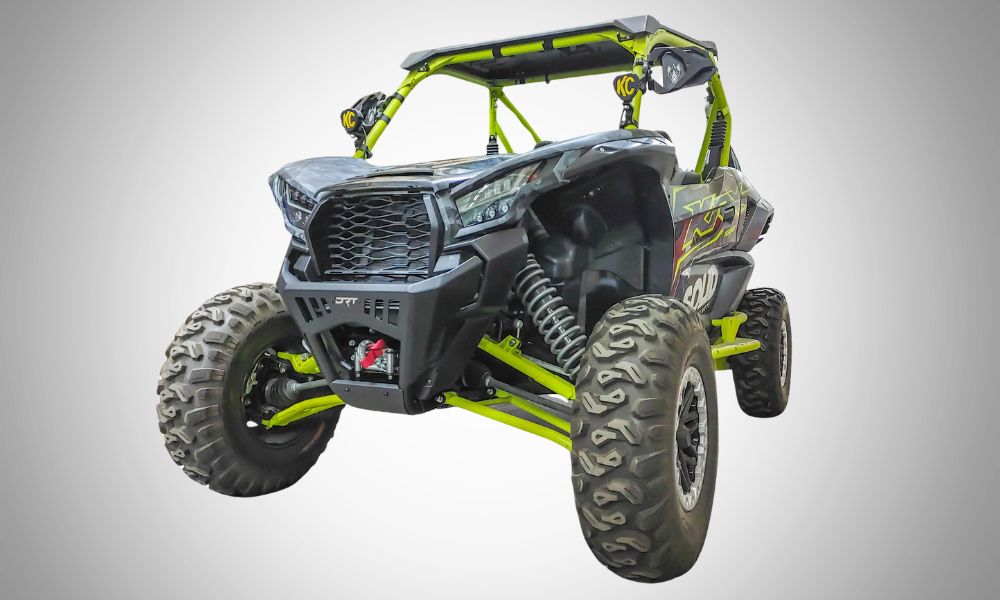Tips and Tricks for Safely Transporting Your SXS

Side-by-sides (SXS) have been carving a niche in the hearts of adventure enthusiasts for decades because of their versatility, off-road capabilities, and the wild thrill they deliver. Yet, with great power comes great responsibility, especially while managing cargo such as a UTV during a long journey.
Proper handling is paramount, whether you’re heading out to a trailhead or transporting your SXS for an exciting event. With years of hauling UTVs under our belts, we think our tips and tricks for safely transporting your SXS could be effective for your towing and other UTV needs!
Preparation Tips
Carefully appraise all your straps and fasteners, the connection points, and the overall condition of the hauler before you load your vehicle onto the trailer or carrier. Look for corrosion on metal parts, rips, fraying, and melted materials on the tie-downs, and confirm all moving parts, like ratchets, function properly.
Check the tire pressure, brake lights, and the tongue and hitch attachment for fitment on the hauler. Confirm the ball mount is the correct size and orientation. Review the weight capacity and ensure the max load is more than what your UTV and all its accessories would amount to.
Observe the trailer at a distance to be sure it’s level. We suggest you do this twice, before and after loading the side-by-side. You don’t want the tongue tilted too far up or down, which can hinder clearance and strain the attachment points. You’ll want to replace or adjust the tow hitch if it’s not level.
Double-check that you’ve securely fastened your SXS to the trailer or over-the-cab hauler (a.k.a., truck rack) before setting off. The golden rule is redundancy—using multiple secure tie-down points, ensuring the straps have a clear path and minimal slack, and aren’t taut around a sharp edge can save your SXS from untold harm.
Every carrier option provides some form of secure “points” functioning as anchors for your tie-down system. While many haulers offer several types of built-in fittings, utilizing different strap configurations could mean those options are not available. Instead, securing tie-downs to the frame and referencing strap manuals for proper usage could be your best bet.
Simpler trailers may lack tie-down points, making the UTV’s frame the solution. We could say the same for the side-by-sides themselves, which also often lack designated anchor points, so use caution. Prioritize the chassis, avoiding bendable, bolt-on, and weaker parts while simultaneously ensuring a clear strap path.
Safety Measures During Transport
The bigger your presence on the road, the safer the journey. Invest in proper lighting systems for your trailer, including brake lights, turn signals, and reverse lights. Add high-visibility flags and consider overpasses, especially if your SXS is extra wide, and deploy reflectors to make your trailer as unmissable as possible.
Safe driving manners are essential in these circumstances. Stick to moderate speeds, allow for longer stopping distances, and make wider turns to accommodate the extra weight and length. You should perform a routine check of the rig—at every road stop, check straps for slack, slipping, and edge wear, especially if you notice a change in sounds or handling.
Towing novice? Become comfortable first before jumping behind the wheel! Practice maneuvers with an empty trailer in a spacious area like an empty parking lot. Focus on reversing, like parking between cones or parking spaces. Be extra cautious entering tight spaces and busy plazas to avoid getting stuck when on the road.
Offloading and Unloading Techniques
The delight of reaching your destination can lead to hasty actions, but patience and precision are crucial. Invest in ramps designed specifically for SXSs with a weight limit that exceeds your vehicle’s. Use a slow and steady throttle down the ramps, ensuring no part of your SXS scrapes the ground, or worse, misses the track.
A driver’s blind spots multiply with the size of the vehicle. Having one or two ground spotters communicate distance and direction can help you ease off safely. They should guide turns and tight spaces and alert you if any part of the SXS is in danger of a collision.
Maintenance and Inspection
An often neglected aspect of transportation is what happens after you’ve reached your destination. As noted above, a quick check-up can make all the difference in preserving your SXS and tie-down system’s integrity. Once you’ve reviewed the straps and connection points, thoroughly review the UTV.
Walk around the SXS and look for any visible damage or loose connections. Also, do a quick operation test to ensure all functions are still in place. Regularly inspect your vehicle for any signs of damage related to transportation—including the brakes, suspension, integrity of the chassis (bends and cracks), and all the usual wear points.
There’s so much more to owning and operating a side-by-side than just turning on the engine and stepping on the gas. Maintaining a responsible attitude toward the greater picture is what keeps this activity enjoyable for everyone. That’s why taking time to educate yourself, practice, and move at a comfortable pace is necessary.
Treating each adventure with the care it deserves keeps the thrill alive and the risks at bay. We hope these tips and tricks for safely transporting your SXS will help you confidently execute your next trip. DRT Motorsports’ selection of off-road aftermarket parts can enhance your SXS experience, so don’t hesitate to check them out.
Responsible handling, from preparation to post-transport examination, ensures your SXS remains a source of joy and not dismay. Take these safety tips to heart and do your part to keep the roads fun and safe for everyone.
